eISSN: 2469-2794


Review Article Volume 3 Issue 2
Department of Science and Technology, Nottingham Trent University, UK
Correspondence: Andrew OHagan, Department of Science and Technology, Nottingham Trent University, Clifton Lane, Nottingham NG11 8NS, United Kingdom, Tel 44 7950875563
Received: July 27, 2016 | Published: December 16, 2016
Citation: Hagan AO, Harris EJ. U.S. Mexican relations: a comprehensive review on heroin supply and demand. Forensic Res Criminol Int J. 2016;3(2):292-305. DOI: 10.15406/frcij.2016.03.00090
As an ever-increasing heroin epidemic pervades the cities and suburbs of America, attempts to tackle the issue have taken prominence in the White House. To fight the ‘war on drugs’ an in depth understanding of the process of production, heroin trafficking routes and previous political policy failures is required. This review focuses on how the production of Mexican heroin dominates the U.S. illicit drug market. A comprehensive analysis of current and previous legislation on drug laws and security regulations at the U.S Mexican border provides suggestions for future policies aimed at tackling the heroin problem in the U.S. Issues explored in this review are; the increased Mexican opium production stemming from the legalisation of marijuana, which shifted Mexican farmers to opium cultivation, the underlying parameters of poverty in Mexico and cartel influenced corruption of government within Mexico. This review suggests that Mexico alone cannot be blamed for the U.S. heroin problem, although it is sole supplier, there must be a demand for the supply within U.S. society. The main reason for the expansion of the heroin epidemic sweeping the streets of the U.S. is the increase in painkiller addition within U.S. society. This coupled with lower cost of heroin on the illicit market may lead many users to replace pain killer cravings with heroin. This poses the question ‘is it realistic to completely remove the heroin problem from the U.S. through the elimination of trafficking routes and by reforming previous failed policies or would drug trafficking organisations alter the structure of their businesses and routes to adapt to any change in policy?
Keywords: heroin, U.S. Mexican border, drug trafficking organizations, supply and demand, border security
When people think of heroin trafficking, Afghanistan and other countries of Asian origin come to mind. A largely neglected area of consideration in both the United Nations World Drug Reports and drug trafficking literature is the dominance of Mexican heroin sweeping the streets of the U.S. feeding an increasing demand. While Mexico accounts for just 6 percent of the world’s opium poppy cultivation, it is a major supplier of heroin to abusers in the U.S. This comes in the form of sticky black tar or a fine brown powder widely available on the illicit drug market.1 This review focuses on the production of opiates and heroin from the opium poppy. It provides a brief historical overview of the drug, the biological pathway the drug takes to produce the desired effect and methods of introduction into the body available to abusers. The review further goes on to evaluate the succession of drug policy failures that attempted to eradicate heroin trafficking across the U.S. Mexican border. An invaluable source of information was supplied from multiple journals and books written by Peter Andreas; such literature includes Border Games, Policing the U.S. Mexico Divide2 and U.S. Mexico: Open Markets, Closed Border.3 Using this knowledge of U.S. Mexican border issues, figures and statistical data from U.S. governmental sources, an assessment will be made to determine to what extent Mexican heroin is feeding the demand by users within the U.S. Factors highlighted in From Maze to Haze; Agricultural shocks and growth of the Mexican drug sector by Oeindrila Dube4 and Mexico’s Drug Related Violence by June Beittel5 are also considered. This review looks at how both countries are complicit in the predicament plaguing the border and destroying lives. Corruption within the government and farming lands of Mexico increases the ability to supply heroin to the U.S.
This review also explores the influential role of Mexico’s drug cartels and how the legalisation of marijuana resulted in a shift of profit margins and a move toward opium poppy cultivation. Mexico cannot be solely to blame for the increased heroin supply to the U.S. across the border by traffickers. In order for this route to exist there must be a demand for heroin within U.S. society. A major source of information used to explore the reasons behind this demand comes from the Centre for Disease Control and Prevention, a significant contributor to the department of health and services in the U.S. healthcare system.6 From this source statistics have been reproduced to show the prevalence of prescription opioid problem in the U.S. This is linked to a discussion on how this problem has contributed to a shift in heroin usage into respectable social classes within the U.S. Consideration of these wide-ranging factors associated with U.S. heroin use and supply permit a judgement on whether or not future political policies can be put in place to curb the prominence of trafficking heroin across the U.S.-Mexican border and its effect on those involved at all stages. Is it realistic to believe that the heroin epidemic can be solved or will solving this problem result in users shifting their addiction to other widely available drugs? Ultimately, are the respective governments fighting a losing battle?
Heroin: A path to destruction
The opium poppy is botanically classified as Papaver somniferum. The genus is named after the Greek word describing ‘poppy’ and the species from the Latin word meaning ‘sleep-inducing’.7 The term sleep-inducing represents the effect that the drug imposes upon the user; the user will be heavily influenced by feelings of relaxation and drowsiness throughout the duration of the high experienced when the drug is taken. The poppy has a growth cycle of approximately 120 days. After 42 days (6 weeks) the poppy is established and by 49 days (7 weeks) the poppy should reach the maximum standing height of around 50-90cm when in favourable farming conditions. The seeds germinate quickly in warm conditions with minimal rainfall during the first few weeks. The poppy requires warm climates with low humidity, little rainfall and rich cultivated soil.7 The most desirable climates which allow the opium poppy to thrive include Central Asia, Southern Asia and South America. Opium is produced when the poppy flower dies. Extraction of opium is from the green pod which swells as it ripens. Opium is only produced in the 10-12-day period in which the pod is ripe.8 Figure 19 illustrates the difference in appearance of the poppy during its life cycle. In the foreground the poppy is in the mature stage of the life cycle with crude opium leaking from the surface of the pod; in the background are poppies in the immature stage showing the flowering process. The extraction of opium from the pod is a labour-intensive process which consists of tapping the individual pods using the blade of a knife to encourage the white sap to drain of out and collect on the outside of the pod.7 As the sap collects on the pod it oxidises and dries. This increases the viscosity resulting in a dark brown resinous gum being left on the surface; this is known as crude opium.7 Crude opium can be modified to produce a variety of different opiates which are abundant in both licit and illicit form within society. For example, the chemical structure of opium can be altered to produce many opiates including morphine, codeine and heroin by adjustment of the chemical formula.10 The production of these opiates is completed by air drying the juices from the pods and boiling to remove impurities.11 In the 16th century laudanum, opium prepared in an alcoholic solution, was used as a painkiller and was widely available to the public as well as patent medicines, syrups, tonics which all contained opium as the principle ingredient.12 Technological advances in organic chemistry during the early nineteenth century led to plentiful supplies of potent habit-forming drugs.13 In 1806, Frederick Sertürner a biologist from Germany isolated the active ingredient in opium and named it morphine after the ‘god of dreams’ due to the desirable effects the drug produced.7 Morphine became a pain reliever after the introduction of the hypodermic syringe in 1953 which allowed the drug to be injected directly into the blood stream to give the patient fast acting pain relief solution.12

Figure 1 Opium Poppies at Different Life Stages.9
The extraction of morphine from the opium lead to in depth chemical analysis of the poppy in order to research medicinal potentials of the drug. In 1930 codeine was synthesised from crude opium by Jean-Pierre Robiquet, Figure 214 this replaced medicinal use of crude opium however did not remove the continuous recreational use of opium which was still present and problematic in urban areas throughout the world. Codeine and Morphine were popular medications of choice in the U.S. during the American Civil War, this frequent medical usage resulted in many people becoming dependant on the drug because of its addictive chemical properties. As a result of the drugs side effects many became addicted to morphine and its use continued and increased through the population after the war had ceased. Heroin was first produced in 1874 where a chemist experimenting with the new upcoming drug morphine in an attempt to find the ‘essence’ of opium.15 C.R. Alder Wright, of Queen Mary’s Hospital in London, produced the drug in order to create a pain killer with an adjusted chemical formula to reduce the addictive nature (which was apparent in morphine and opium) whilst mimicking the desirable medicinal effects.15 Many other pharmaceutical companies investigated the newly founded drug, however most saw no future for the drug and were hesitant to manufacture it. In 1897 Deser a German chemist assisted by Hoffman, working for Bayer’s Pharmaceuticals, tested acetylsalicylic acid and diacetylmorphine (commercially known as aspirin and heroin) on animal’s humans and themselves.15 This led to the discovery that the drugs were an effective treatment for respiratory diseases such as Tuberculosis, Bronchitis and asthma which lead to the exportation of free samples from Germany to 23 countries worldwide. Pharmacists distributed the drugs to members of the public addicted to morphine and opium as an attempt to the reduce use of these drugs.15 Doctors and Pharmacists soon realised the addictive nature of the two new products on the market, heroin was especially sort after by members of the public and in 1913 British Pharmaceutical Company Codex determined that heroin was two times as addictive as Morphine, shortly after this discovery Bayer’s Pharmaceuticals ceased production of the drug.15 Heroin is a categorised illicit drug which is semi-synthetic, the final product of opium formed via series of man-made manufacturing processes. These processes consist of a purification stage, an isolation stage and a conversion stage. Firstly the opium is dissolved in water, the desired alkaloids dissolve in the water and the impurities are then strained from the mixture creating a purer form of opium.11 Isolation of morphine is next in the process, heroin being derived from the chemical structure of morphine. This isolation process involves the purified opium being dissolved in water with the addition of lime to produce a saline solution.11 The solution is strained to keep the purity of the substance at a high percentage. This then forms a precipitate within the filter allowing aqueous impurities to be removed. The morphine precipitate is then converted to heroin by combining it with acetic anhydride under specific conditions; the result of this is the production of heroin hydrochloride (diacetylmorphine HCl). This drug is most commonly taken in order to relieve pain and induce sleep (commonly classified as a narcotic or opioid). Initially when heroin was first synthesised it was thought of as a ‘wonder drug’ when pharmacological studies in 1898 proved it to be more effective than morphine or codeine. As a consequence, the drug was produced on a large commercial scale before the dangers of the drug became apparent Figure 3.11
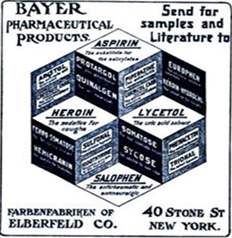
Figure 2 Advertisement of Bayer Pharmaceutical Products.15
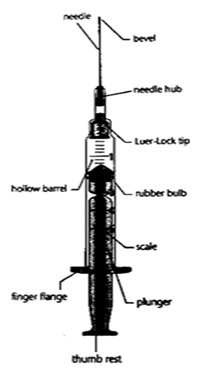
Figure 3 Diagram of hypodermic syringe.11
Heroin is a more effective drug than other derivatives of opium. The acetylation of heroin shortens the biological pathway within the body, as this chemical group increases the permeability of the drug allowing rapid transition across blood-brain barrier. Enzymes present in the brain convert the heroin back into morphine, by deacetylation, this then binds to opiate receptors within the brain.16 These receptors control perception of pain and happiness and, in addition, regulate processes such as blood pressure, respiration and sexual arousal.16 Initially the user experiences a sense of wellbeing and euphoria however, this is typically short lived and soon diminishes sending the user into a downward spiral of negative emotions. This makes the user crave another high resulting in further heroin consumption, commonly developing into an addiction.16 A person can develop a physical dependence to heroin after the first dose due to its desirable side effects. This is the major reason it is considered to be a dangerous drug. There are a large number of addicts worldwide; the drug plagues all types of societies. There is no definitive type of person which can be considered representative of the stereotypical heroin addict; society’s perception is distorted with the belief that the lower class is plagued with heroin addiction. This is not always the case; many addicts begin addiction to heroin after being legally prescribed opioid medication such as Vicodin and OxyContin for pain relief. These drugs are prescribed to people all over the world and produce the same effects as heroin which can result in the user having a strong dependence to the pain medication. When no longer prescribed, they may turn to heroin as a substitute for the prescription drug.
The World Drug Report 2015estimates that, from the limited information available, there are currently 32.4 million opioid users and as a result for this demand global opium cultivation reached its highest level in 2014 where production reached 7,554 tons.17 The global demand led to a rise in poppy cultivation and opium production in the poppy producing countries. Heroin found on the illegal market, often referred to as ‘on the streets’, takes many different forms and is often indicative of the country in which the drug is produced. The most common appearance is in the form of an off-white powder. The drug is very rarely found in pure form. It is normally mixed with substances such as powdered milk, sugar, starch and in some cases adulterated with strychnine. These additives increase the bulk weight of the drug enabling dealers to dilute the pure product to increase profit margins. These contaminates adjust the colouration of the powder resulting in the drug being more commonly found in a brown powder form, particularly when exported from places of production such as Central and Southern Asia. In some cases, heroin, can resemble a sticky black mass, this is commonly referred to as ‘black tar’ heroin.16 This heroin may be sticky like roofing tar or hard like coal, with its colour varying from dark brown to black and is most prevalent as a drug in the United States.18 This prevalence stems from the close proximity of the country to the Mexican border where ‘black tar’ heroin is produced in abundance. Crops are grown here in order to meet the supply and demand for the drug by its neighbouring country. Although Afghanistan produces the majority of the world's heroin found on the streets globally, South American heroin has become the most prevalent type available in the U.S particularly in the Northeast, South and Midwest.18.1 Heroin is primarily taken through four routes; smoking, oral inhalation, snorting/sniffing and injection (intravenous and subcutaneous).19 Routes of administration vary throughout the world, oral inhalation can consist of smoking a cigarette which has been dipped in a liquid form of heroin; an administration technique known as ‘chasing the dragon’.20 Oral inhalation involves heating the heroin to alter the viscosity to emit vapour. Then when the substance is run over foil this vapour is then inhaled using a pipe so the drug enters the blood stream via the nasal passage.21 Smoking the drug enables the effects to be produced within 5-15 seconds of administration whereas oral inhalation can take between 60 to 90 minutes to take full effect.21 Snorting the drug involves crushing the heroin into a fine powdered which is taken up through the nose to enter the blood stream similar to cocaine. The most efficient administration of the drug is intravenous (IV) or subcutaneous/intramuscular injection. IV injection allows the drug to be injected directly into the blood vessels; effects can be felt immediately in about 15-20 seconds.19 The user can experience the desirable side effects of the drug for up to 3-5 hours after administration.21 this is a popular route of administration amongst addicts who commonly use a hypodermic syringe in order to get their high. However, IV injection has the most risks associated with repeated use, over time the walls of the veins are broken down and can no longer be used as injection sites this is known as ‘muscling’ or ‘skin popping’.19
Heroin injection is hazardous as addicts often do not pay sufficient attention to hygiene and the importance of maintaining a clean environment; their key priority is getting their next fix. The re-use of dirty needles can increase the risk of infection, HIV/AIDS and Hepatitis B or C.19 Addicts who progress from medically prescribed drugs tend to use the injection route immediately as it gives them an almost instantaneous high, so mimicking the action of the prescription opioids they have previously taken. Experimental users are more likely to begin with oral use, sniffing or snorting then often progress to the intravenous route.19 Withdrawal symptoms are often experienced and peak within 48 hours after the last fix of the drug (this time may fluctuate with differing degrees of tolerance and consummation amounts).16 These ‘cold turkey’ symptoms are not seen as a medical condition but do involve undesirable effects such as body aches, nausea, insomnia and muscle cramps. Frequently the user will continue to take the drug rather than risk these unpleasant side effects which in many cases can result a high dependency on the drug.16
In the U.S. drugs, substances and certain chemicals used to make drugs are classified into distinct schedules under the Controlled Substance Act 1970. These drugs are categorized depending on the drugs acceptable medical use, abuse of the drug or dependency potential Figure 4.22 Heroin is categorized as a Schedule 1 drug, the most dangerous and addictive group; consequently prison sentences for production or trafficking of the drug can range from 5 years, for a first offence involving low quantities (less than 999 grams heroin), up to life imprisonment.22,23 However law enforcement has not prevented heroin abuse and dependency within the US and heroin addiction remains a growing problem in the country putting enormous strain on the government’s drug enforcement agencies and the healthcare system. To understand how political enforcements failed to prevent drug trafficking at the border; knowledge of trafficking methods and concealment techniques is required. This is summarised in the table below24-28 Table 1.
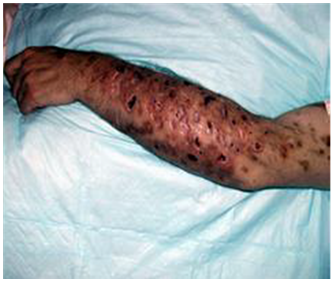
Figure 4 An example of a severe case of skin popping as a result of veins collapsing due to repeated injection of heroin.22
Method |
Description |
Images |
Body Packing |
Body Packers, also be referred to as ‘swallowers’, ‘internal carriers’ or ‘mules’, this interchangeable |
|
Concealment within Luggage |
Drug concealment in luggage and vehicles crossing the border continuously evolve to control stay |
Figure 6 Heroin found in modified tyre coming across the border from Mexico.28
Figure 7 Heroin found in Coca-Cola can coming across U.S.- Mexican Border.28 |
Table 1 Heroin Trafficking Concealment Techniques
The U.S. political battle against drugs
>History has shown that the U.S. has been acutely aware of the problems caused by drug use and abuse within its society. In an attempt to combat such problems, laws were put in place as early as the late 1800s/early 1900s to restrict the use of substances such as opium, cocaine and marijuana.29 However the issue was not formally reorganised in presidential office until 1969 when the U.S. election saw Richard Nixon compete to gain a term in presidential office. During campaigning, Nixon focused on the battle against drug use and abuse in the U.S. which became part of his main campaign. This appealed greatly to his core supporters who had grown weary of the effect increased drug use had had on the inner city areas and in society as a whole.29 With the promise of change for the U.S. Nixon became the front runner in many constituencies within the U.S. After winning the elections in 1969 he led the country with the aim of facing a countrywide war on drugs. President Nixon declared a “war on drugs” in June 1971. He dramatically increased the size and presence of federal drug control agencies; these agencies focused on controlling the production of the opium poppy, the growth of various other illegal drugs in producer countries and pushed through measures such as mandatory sentencing and no-knock warrants (these allow enforcement officers to enter a property without prior notification) which expanded the law enforcement powers.30 Nixon reorganised the federal drug law enforcement effort by establishing the Drug Enforcement Agency (DEA) and the National Institute for Drug Abuse which increased the law enforcement capacities fighting against the war on drugs. Supplementary to this, in 1972 Nixon announced that heroin addiction was ‘public enemy number one’ and increased the budget for the Bureau of Narcotics from $14 million to $74 million in the first three years of his first term.31
These law enforcement efforts mainly focused on tackling the influx of drugs from Latin American countries through the vulnerable border dividing the south of the U.S. from the northern territories of Mexico. The U.S.-Mexican border stretches for about 2000 miles and was formed in 1848 under the Treaty of Guadalupe Hidalgo established at the end of the two year American-Mexican War.16 To the present day this border divide runs entire breadth of the continent from the Pacific Ocean to the Gulf of Mexico, and incorporates 25 U.S. counties on the southern American border and 38 Mexican municipioson the Northern Mexican border. Since the creation of the constitutional divide between the U.S. and Mexico efforts have been made to create man-made divisional barriers to separate the two countries Figure 8.16 In addition, attempts, have been made to increase the security levels along the border by erecting watch towers and chain link fences particularly at the most commonly used crossings (around the San-Diego-Tijuana crossing and the El Paso-Ciudad Juarez crossing) to deter the influx of migrants into the U.S. and gain greater control over drug trafficking.16 These efforts worked to an extent, however migrant influx and drug trafficking were still prevalent at border crossings. This shows the adaptability of drug traffickers to adjust the trafficking routes in order to smuggle drugs across the border even with tighter security measure put in place. In the 1980’s this term was coined playing a game of cat and mouse, due to the process of simultaneously exerting and avoiding control at the border.32 In order to eliminate the drug smuggling issue, greater security and control measures were required. Eventually 10-foot-high steel fences replaced the original chain linked fences and infrared cameras were introduced together with an increase in border patrol units and spotlights that remain present today16 Figure 9.
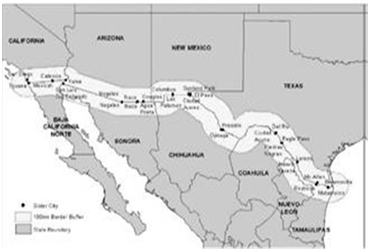
Figure 8 Constitutional Division between the U.S. and Mexico border regions.16
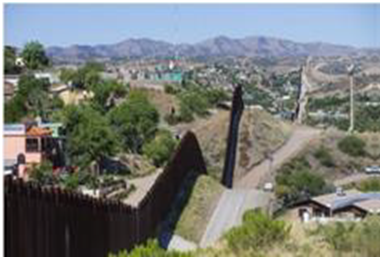
Figure 9 Example of steel fence enforcing border division.28
President Nixon also introduced Operation Intercept in 1969 in an attempt to reduce the importation of illicit substances travelling across the U.S.-Mexican border.33,34 This operation strengthened security at the border and increased the power of the enforcement agencies. These measures included stringent personal and vehicle searches and extensive questioning of migrants on the U.S. side of the U.S.-Mexican Border. These search methods were very time consuming and border crossings were brought to a virtual stand-still. Many complaints were made about over-zealous inspectors.34 Unfortunately few arrests were made as smugglers became wise to the operation, often resorting to aerial drops across the border, and Operation Intercept was abandoned after only 20 days.34 Relations that were already tense between the two countries worsened and have remained poor for many years. Due to the drug trafficking problem remaining prominent at the U.S.-Mexican border almost 40 years after the issue was first addressed, it is apparent that the tightening of security measures has not proved irradiating the drug trafficking issues completely. In addition, Nixon’s term in office can be seen as producing policies with problematic outcomes. The most significant influence Nixon had was the adjustment of U.S. society’s view on the use of illegal drugs. His war on drugs created a negative stigma, users were no longer seen as sick members of society but were seen as a menace and imprisoned. This did little towards helping users to fight their battle against addiction but isolated them from society which many argue encouraged them to carry on using. Although Nixon was in presidency for a short period of time, it is evident that his policies highlighted the awareness of the drug problem but did little in terms of eradicating it and the associated issues. Understandably, the war on drugs was going to be a long process and wasn't going to be solved overnight; some believe Nixon created the first step in the right direction by changing the U.S. attitude to the habitual use of illicit substances.
This attitude was expanded upon when Ronald Reagan took up presidency in 1981, his wife, the first lady, created the highly publicised “just say no campaign” which supported a zero tolerance policy when it came to the matter of drug use and abuse.31 The aim of the policy was to raise the profile of the problem by flooding the American education system and the media with anti-drug messages.31 The policy was the first in-depth campaign which emphasised that American culture was battling drug use and distribution within all classes and different racial groups throughout the country as a whole. Reagan at the time was quoted: “We can put drug abusers through stronger law enforcement, through cooperation with other nations to stop the trafficking, and calling on tremendous volunteer resources of parents, teachers, civic and religious leaders and state and local officials”. “We are rejecting the hopeless attitude that drug use is so rampant we are defenseless to do anything about it. We’re taking down the surrender flag that has flown over so many drug efforts; we are running up a battle flag. We can fight the drug problem and we can win.” Ronald Regan.31
Reagan further increased the battle against drugs by mobilising the U.S. military’s involvement. The military supported the administration’s drive to intensify exclusion efforts along the U.S. borders, and to aid the eradication illicit crops throughout Latin America to support the law enforcement policies in the countries involved.35 The policy promised a change in American society, however this did not happen, it did the opposite. Drug use and abuse increased dramatically during the 1980s, drug related violence and crime reached epidemic proportions.35 This highlighted the ineffectiveness of simply increasing security budgets and legal enforcements in a bid to tackle the war on drugs. The policy itself, taken at face value, should not have failed particularly due to the popularity of the president, who had virtually unanimous support and widespread public approval. Despite the policy’s promise to U.S. citizens a combination of factors allowed serious weaknesses to emerge. The health service became overwhelmed treating users and the Drug Enforcement Agency (DEA) struggled to cope with the sheer volume of work. Significant under funding of these organisations hindered their ability to provide the service pledged by the policy. The budget was also overwhelmed with the demand from President Reagan for the incarceration and zero tolerance policy for habitual users.36 These tough new federal drug laws led to soaring rates of imprisonment for drug use and possession, imposing steep minimum sentences for the use and sale of controlled substances, notably heroin and cocaine.36 People convicted of drug offences came to make up one fifth of all state prison inmates and two thirds of all federal inmates by 1997.37 This is shown in the graph below which has been reproduced from the U.S. Graph 1. Bureau of Justice Statistical Data.38 The effectiveness of the war on drugs further reduced when Clinton took up his term in office. Under Clintons rule, the North American Free Trade Agreement (NAFTA) established a free-trade zone in North America; it was signed in 1992 by Canada, Mexico, and the United States and took effect on January 1st 1994.39 NAFTA immediately reduced tariffs on the majority of goods produced by the signatory nations. The aim was to encourage trade between member countries by reducing the cost of goods crossing borders.39 The policy liberalised the movement of legal trade across the borders; however unforeseen effects detrimental to the war on drugs materialised because of the agreement. A failure to acknowledge the parallel movements of the legitimate and illicit markets resulted NAFTA opening the borders expanding the illicit trade between countries. This significantly hindered the progress in the U.S. In addition, NAFTA countries within the agreement had to form joint decisions on restrictions relating to cross border movement.

Graph 1 Data reproduced from the U.S. Bureau of Justice Statistical Data showing the volume increase incarceration statistics 2001.37
The U.S., being a most influential country, with strong opinions on drug trafficking across borders, tried to impose its policies and view on Mexico by challenging drug supply sources. The main policy aim was to increase eradication of crops such as marijuana and opium. This eradication hoped to lead to a reduction of drugs such as heroin crossing the border. However, the prevalence of the drugs and the inadequate salaries for low-level government employees and law enforcement led to political and police corruption being common in Mexico.36 Mexico has a high level of poverty within the country which presents opportunities for drug manufacturers and traffickers to offer financial incentives to individuals and their families in order to manipulate the governing system. The U.S. imposition of policies on Mexico resulted in a strain in international relations with Mexico opposing the idea of U.S. control. In 2001 during President George W. Bush’s term in office he attempted to rectify the detrimental effects of NAFTA. In the U.S., he mounted a campaign and committed to unprecedented expansion of police, prisons, prosecutors and courts. However, placing less emphasis on finding the cause of drug abuse in the U.S.36 Such action could have reduced the number of individuals going through the legal process thus reducing costs and workload. Unfortunately, despite political efforts to solve the drug issues a huge problem of drug trafficking and abuse remains to this day in the U.S.
The Mexican political battle against drugs
Over the decades, the U.S. and Mexico have approached the increasing problem of drug abuse, production and trafficking in different ways. As mentioned in the previous section, the U.S. battled the problems head on with the declaration of the ‘war on drugs’. This targeted Mexico as a key site for opium eradication and increased security at borders to deter traffickers from importing the drug into the U.S. On the other hand, Mexico in the early part of the 20th century, pursued what analysts call a ‘live and let live’ approach to the drug war.40 By no means did this mean that the authorities supported and aided drug traffickers and manufacturers within the country, but it explains the passive attitude towards criminal groups manufacturing and trafficking drugs. For the most part, this frustrated the U.S. government because its active approach was not reciprocated by the neighboring country who played a role in part of the problem they were trying to minimize. Mexico, during the first ten years of the century, was preoccupied with the revolution of 1910, after which there was great uncertainty in the country’s political structure.1 For example by 1916 the Mexican government passed a law to prohibit opium trade across its borders; this was further supported by the ban on importation of any narcotic substance in 1923.1 This approach progressed into the formation of Mexican decree to outlaw the exportation of heroin and marijuana from the country. Each act resulted in tightening security at the border crossing with the U.S. and other Latin American countries.
The adjustment and quick progression of the law in Mexico is attributed to the need to pacify the U.S. and conform to the emerging international drug prohibition regime.36 In the early twentieth century Mexico depended heavily on the importation of U.S. goods across the border as their main produce to sell on the local markets.41 This furthered the need for conformity to the U.S. attitudes towards drug enforcement due to the economic sanctions imposed on the country by the U.S. Change came in the 1930’s when the great depression period began and as a result of this the U.S. imports to Mexico and other countries in Latin America declined sharply.41 Mexico along with the other countries had previously relied on the U.S. produce began farming their own produce to sell on the local markets. This reduced the amount Mexico had to rely on the U.S. and provided many citizens living in rural areas with jobs. However, with the incomes in this area of work low, many farmers were persuaded to use their land to cultivate illicit crops instead because the profit margins were more financially beneficial. Carlos Salinas de Gortari assumed the Mexican presidency in December 1988, he faced the daunting task of coping with a more powerful, internationally connected Mexican drug smuggling business.1 President Reagan’s mass propaganda and media campaign to curb drug abuse and smuggling across borders put pressure on Salinas to sign up to policies and agreements with the U.S. Eleven days after taking office Salinas assured a visiting U.S. congressional delegation that he would “make life miserable for drug traffickers”.1 Salinas declared that drug trafficking was the number one threat facing the nation, he entered a bilateral treaty with the US in 1989 called the Treaty of Cooperation for Mutual Legal Assistance. This extended to giving power to the military to become involved in drug eradication. The military became supreme authority and in cities such as Oaxaca, Sinaloa, Jalisco and Guerrero the only authority.42 The increased legal authority within the country was a promising prospect for eradicating the drug cultivation problem and tightened Mexico’s relations with the U.S. The build-up of the Mexican anti-drug effort was particularly impressive as budget cuts in government were being made at the time.1
Graphs 2 & 3 43 shows the eradication effort made by law enforcement agencies in Mexico to curb cultivation of the opium poppy. The graph shows no significant increase in eradication with growth fluctuating around the 15,000-hectare mark. These stagnant figures in eradication could be the result of corruption within the government which is explained within the next section. Salinas expanded police powers however many argued that this only deepened the penetration levels of corruption within government. Salinas would have benefitted from reforming Legal enforcement agencies and battling corruption head on rather than just extending the power within already corrupt forces. This would have given a better chance to eliminate corruption from within the legal system. In 1994, still under the rule of Salinas, the North American Free Trade Agreement (NAFTA) established a free-trade zone in North America.37 Before NAFTA it was assumed that Mexico would be the greatest benefactor from the agreement due to its close proximity to the powerful U.S. trading partner. The tariff rate in Mexico fell from 12 percent in 1993 to 1.3 percent in 2001. In addition, U.S. import tariffs to Mexico fell from around 2 percent to 0.2 percent.41 The outcome of this was to increase legitimate trade between the U.S. and Mexico. This was advantageous for the underdeveloped Latin American country and helped develop agricultural business in Mexico. NAFTA had unforeseen effects and impacted the Mexican economy. The agreement did not result in the desired social and economic revolution for Mexico. President Salinas was blamed for the decreased standard of living, economic difficulties, and the massive corruption that occurred during his administration.44 The policies of free market trade and economic integration enhanced the trade of illicit substances across the U.S. Mexican border.45 The unseen effects were two-fold. Mexican drug trafficking organisations smuggled illicit drugs to markets in the U.S. whilst less stringent gun laws in the U.S. resulted in an influx of arms into Mexico; often income generated from drug smuggling activities was used to purchase weapons which were then used by Mexican drug cartels. An unintentional increase in drug related violence plagued the streets and remains to this day. Salinas drug eradication efforts were followed by presidents who preceded him. The pattern accelerated greatly during the Fox and Caldron administrations, which deployed tens of thousands of troops throughout the country.45 Efforts to reduce violence brought mixed results. Many argue militarization has produced a dramatic increase in violation of human rights, contributing to corruption and defection of Mexican military personnel.45
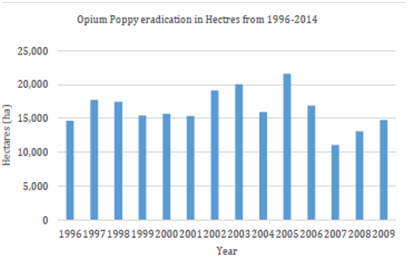
Graph 2 Opium poppy eradication efforts by the Mexican government reproduced United Nations World Drug Report 2011.43
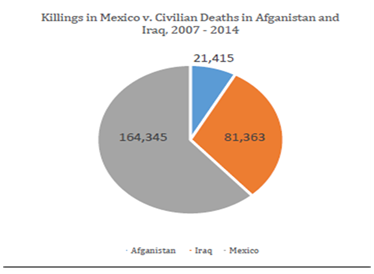
Graph 3 Is reproduced using from United Nations Statistics to show the extent of homicides which occur in the country by comparing the data to that of countries with abundant tolls, such as Iraq and Afghanistan.48
The Mexican drug war: reasons for feeding the U.S. demand
Over the past few decades Mexico has been the main country supplying the demand for heroin in the U.S. There are three main underlying factors contributing to this and these are shown in Figure 10 below. First and foremost is the extreme poverty in Mexico with the poor provision of clean water, good nutrition, decent health care and education in many areas. Such poverty has increased the willingness of farmers to produce illicit profitable crops to provide for their families. Secondly widespread corruption within governing bodies and law enforcement agencies has enabled the drug trafficking organisations (DTO’s) to prosper and exert even more pressure on the farmers to produce illicit crops. Finally, the legalisation of Marijuana in the U.S. has led to a shift from the production of marijuana to opium cultivation to meet the increased demand for the drug. The Influence of DTOs on Law Enforcement Agencies. This combination of factors has resulted in the increase of the heroin drug trade across the U.S.-Mexican border. This expansion has resulted in an explosion in violence associated with drug trafficking spreading across Mexico claiming thousands of lives and reaching such a high level of intensity and ferocity many citizens have become paralysed by fear.5 The violence stems from the DTOs which are often referred to as cartels. There are several highly influential drug cartels in Mexico and these groups profit by feeding the U.S. demand for heroin and other illicit substances by trafficking such products across the border. Multiple DTOs within certain areas of Mexico have combined to make a variety of cartel groups with names based upon their locations. The four main drug trafficking organisations are; the Sinaloa Cartel, the Tijuana Cartel, the Juarez Cartel and the Gulf Cartel; these groups are mostly located in northern Mexico in close proximity to border crossings.46 These organisations have significantly increased the drug trafficking at the U.S.-Mexico border by using the large sums of cash smuggled back from the U.S. in return for the illicit supply of drugs. This vast quantity of money is often used to bribe and corrupt Government bodies, Mexican law enforcement and federal police forces in order to actively support the cartels, to turn a blind eye to the cartel activities or protect them from the law.5 The DTOs assert this power over law enforcement agencies by monetary persuasion and by the threat of kidnapping, torture and violence upon themselves or loved ones as a form of blackmail. This endemic corruption is rife throughout the military, police and political bodies in Mexico and allows heroin and other illicit substances to be smuggled across the border with relative ease to feed the U.S. demand.2

Figure 10 Summary highlighting reasons for Mexican farmers being the main provider heroin to the U.S.
In October 2008 two former heads of the Interpol Police Force in Mexico were arrested for alleged ties with the Sinaloa cartel. In addition to this in November of the same year Noe Ramirez Mandujano, head of the Attorneys General Office, was arrested and accused of accepting bribes from a drug cartel.47 These cases illustrate the extent of corruption which is occurring within the Mexican legal system. Furthermore, influence is also exerted by the DTOs on the Mexican media. The cartels use similar techniques of bribery, corruption and threats of violence on the media in an attempt to influence reporting and sway public opinion in their favour. They are able to manipulate the media to promote biased reporting in favour of the cartels.46 The media alter the perspective of drug trafficking to make it look less problematic than it is, thereby reducing the urgency of the government in addressing the issue due to the media’s skewed representation. Mexican cartels are portrayed more favourably than they should be due to this misrepresentation. In addition, a cartel’s influence over the media can limit weaknesses being reported thereby allowing their continuation of power within their region. If reported, the weaknesses of a cartel could potentially allow rival groups to take over with all the associated violence that would involve. Removal of the pressure on the media by the DTOs would permit the true depiction of cartel influence, corruption and violence associated with the drug trade. If it existed, unbiased objective reporting may positively influence cooperation of Mexican citizens in assisting law enforcement agencies with the issues surrounding drug trafficking as they would better informed about the endemic problems within their country. In order to continue to traffic drugs the DTOs constantly battle for land or ‘turf’ and are involved in shoot outs and fights with rival groups to gain control of land close to the U.S. Mexican border. Often innocent people have been caught in the cross-fire between rival groups when battling for ‘turf’. It is hard to determine the extent of drug related violence in Mexico especially when referring to homicide statistics due to many murders never being investigated.48 Therefore Mexico has no annual figures on organised crime homicides, however there is general homicide statistics that when compared to other counties are shocking. The Mexican government released statistics that between the years of 2007-2014, the bloodiest years against the cartel rule, in this time period there were more than 164,000 homicides recorded.48 The general consensus when determining cause of death is that if someone is killed by a high-calibre or automatic firearm they would be counted as a victim of organized crime, but if they were strangled or stabbed to death, they would not necessarily be considered a casualty of the drug war.48 According to Milenione newspaper (a national paper published across 11 cities), around 50% of the total number of intentional homicides are reported to be the result of organised crime.49 However INEGI (National Institutes of Statistics Geography and Information) data shows as little as 38.7% of total homicides in Mexico are the result of organised crime.49 Using this range it can be determined that between 56,636 people and 82,163 people have killed as a result of organised crime between the years of 2007-2014. Many efforts and revisions of policies have been reviewed in order to eliminate the DTOs from the streets to protect the innocent lives being destroyed. Efforts have been made to destabilise and disrupt DTOs using undercover law enforcement officers with the aim of arresting and imprisoning the most influential leader of groups. This removal of key members of the groups has had some success; for example, the imprisonment of Cardenas and Arellano. In spite of such successes, the enormity of the cartels’ power and lax jail conditions within Mexican prisons has permitted the traffickers to continue to run their businesses from within the jails.46 One of the key problems with disrupting the control of DTOs by these arrests was that there was often a surge of violence as rival groups fought to take control. A question remains over whether the disruption of the cartels and the resulting violence loss of life is too high a price to pay in the war against drug trafficking. An alternative view on drug related violence associated with the disruption of the cartels is that the resultant infighting could cause self-destruction of the DTOs with little input from law enforcement agencies. This view is held by Jorge Hanks, Mayor of Tijuana, a city near the border where violence is prominent. His beliefs also include the suggestion that unless you are involved with the cartels then you should have nothing to fear.46 However, the DTOs’ abilities to replace members lost through arrest or violence into the hierarchy, and other roles within an organisation, should be taken into consideration when examining this theory.3
Legalisation of Marijuana in the U.S
Another factor affecting the increased importation of heroin into the U.S. was the legalisation of marijuana and the availability of this drug for medicinal purposes in 20 of the states within the U.S.51,52 This greatly reduced the black-market value of marijuana and its value to the Mexican farmer producers. Border Patrol has been seizing steadily smaller quantities of the drug, from 2.5 million pounds in 2011 to 1.9 million pounds in 2014.53 Mexico’s army has noted an even steeper decline, confiscating 664 tons of cannabis in 2014, a drop of 32% compared to year before.53 This change in legislation in the U.S. allowed the marijuana crop to be grown within the country and so replacing cheap, low quality, hard-packed version harvested by the bushel in Mexico’s Sierra Madre mountains. This has shifted the U.S. market away from the production of Mexican marijuana, towards a home-grown crop with increased potency and quality and overall a more favourable product. In turn this has had repercussions on the illicit crop production in Mexico. Opium poppy cultivation has grown and is expected to continue to increase due to the market profitability shifting away from the marijuana crop. This theory is supported by the production statistics provided by the U.S. International Narcotics Control Strategy Report which states that heroin production has increased from 49 – 325 tonnes between the periods 1993 and 2006.54 A further contribution to the shift in opium poppy production was the fall in profits from the cultivation of legitimate crops. It is estimated that there was approximately a 59% fall in maize prices between 1990 and 2005.4 The reduction in profits from the cultivation of both marijuana and legitimate crops resulted in Mexican farming communities increasing production of illicit opium to maintain their income.
The DTOs influence on Mexican farmers and crop cultivation
The cartels wield substantial power over the Mexican farmers who cultivate illicit crops such as opium for heroin production through financial incentives and threats of violence and intimidation. In order for the DTOs power and influence over farmers to be reduced the issue of poverty and government control in Mexico must be addressed. If the price paid to farmers to produce legitimate crops was increased it could reduce the willingness of the farmers to be compromised by the DTOs to produce illicit crops. In addition, increased wages and better law enforcement resources may go some way to minimise the hold of the cartels over government officials and ultimately reduce corruption within the system. On the other hand, a flaw in this theory may be that the DTOs increase the amounts they are willing to pay to the farmers and government officials to secure production of heroin and other illicit substances. A potential game of ‘cat and mouse’ could ensue. Arguably there needs to be a joint approach between Mexico and the U.S. on this aspect of the drug trafficking trade. Currently the U.S. works with Mexican government to provide support to opium poppy producers by creating incentives for opium growers to produce legitimate crops.3 Furthermore joint cooperation between the two countries is required to strengthen disincentives to participate in the narcotics industry through increased law enforcement and a purge against corruption.43
The increasing U.S. heroin problem
Heroin use has increased across the U.S., among men and women, most age groups, and all income levels.6 The increase in part can be attributed to an ever-rising population addicted to opiates and the lowering of the price of heroin. The Centre for Disease Control and Prevention (CDC) in the U.S. refers to the problem as an epidemic55 and has identified a shift in the population who abuse the drug. Abuse has moved from minority populations living in impoverished inner city conditions towards young middle class citizen living in close proximity to urban areas. A recent study determined a number of groups within the U.S. population who are most at-risk of heroin dependence; non-Hispanic whites, people between the ages of 18 and 25, Medicaid recipients, men, people who don't have health insurance, and people who make less than $20,000 a year55 (which may be on the increase as a result of increasing rates of unemployment). Figure 11 highlights the issues which should be addressed when looking at reasons for the demand of heroin within the U.S.
Painkiller addiction
Analysis of historic statistics show that people who began using heroin in the 1960s were predominantly young men whose first opioid of abuse was heroin.56 However, more recent users were older men and women living in less urban areas who were introduced to opioids through prescription drugs.56 Prescription drugs have similar biological effects on the body to heroin. Pain and suffering is reduced by the analgesic properties and there is a close relationship between chemical formulas of both prescribed opiate based drugs and heroin. A consequence of prescription drugs being so closely related in chemical structure is that they have similar addictive properties to heroin and can encourage consummation of the drugs after the prescription period has terminated.5 Illicit use of prescription pain killers is the fastest growing substance abuse problem in the United States and the main reason for seeking addiction treatment services throughout the world57 Figure 12. In an attempt to reduce this problem some of the physical properties of opiates have been altered in order to act as a deterrent. For example, OxyContin has been adjusted physically by packing the contents into pills of reduced size increasing the hardness of the medication in order to cause problems for the abuser when snorting or crushing the drug. It is debatable to what extent the physical transformation have deterred the use of illicit opiates, due to the dependency levels being so great substitution is more likely to result than total deterrence. The total number of opioids prescribed in the United States has skyrocketed in the past 25 years. The United States is biggest consumer globally of opioids, accounting for almost 100 percent of the world total for hydrocodone and 81 percent for oxycodone.58 This increased use is reflected in deaths from drug poisoning indicated in Graph 4.59 Several contributing factors can be linked to this increase in use of opioid prescription drugs. One factor is that doctors have been more willing to prescribe the pain-relieving drug to the population without a risk assessment to determine to likelihood an addiction may result.
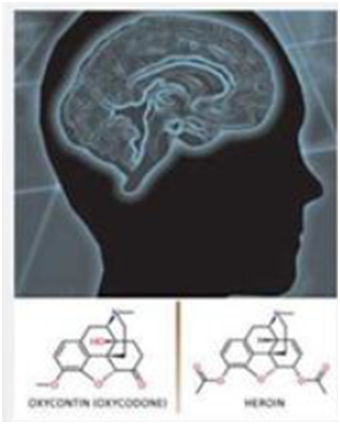
Figure 12 Comparison of Chemical composition of common pain killer and heroin, explaining why they have similar effect on the body.57
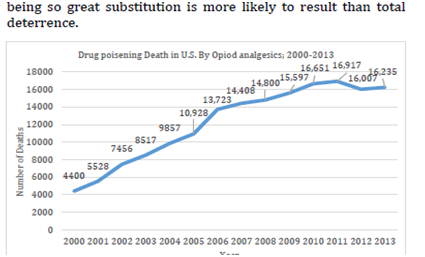
Graph 4 Statistical demonstration of the pain killer addiction plaguing the U.S. Citizens Reproduced from.59
Lower prices of heroin
The market has shifted away from illicit use of prescription opiates towards heroin for many reasons. Firstly, the cheap price of heroin on the illicit market means than many substitute pain killer addictions for that of heroin because the drug can satisfy the craving at a lower cost.61 The substitution of pain killers with heroin may be a factor in lowering the cost of heroin on the street. The greater the sales of heroin, the more money street dealers earn which theoretically could result in a chance to offer lower prices to a larger consumer market. However, this may not be the case if dealers maintain prices in order to make increased profit margins. Lower prices of heroin may be a result of the ever-increasing willingness of Mexican farmers to supply the drug (refer to previous section), a case of the supply meeting the demand. In situations where the demand exceeds the supply the price would increase due to competition between buyers for the drug where dealers can charge a higher price. The reverse applies where supply is abundant. The close proximity of Mexico as the producer and the U.S. as the major market also contributes to lowering the price of heroin due to reduced trafficking costs. Fewer people are needed to traffic the drug and the traffickers have only one border to cross in order to distribute drugs. This reduces the amount of time and money spent on the trafficking route. However, improved border security and law enforcement will have an effect on the amount of heroin arriving in the U.S. from Mexico potentially increasing the cost. Many traffickers are unwilling to risk getting caught if there is no substantial monetary gain. This could be the reason for the slight plateau of heroin prices shown in Graph 5 below.62
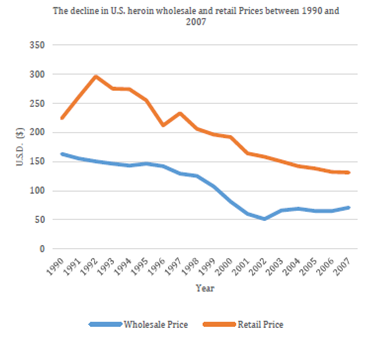
Graph 5 Representation of the decline in value of heroin available on the streets of the U.S, reproduced from the United Nations Office on Drugs and Crime - World Drug Report 2009 statistical data.62
An escalation in border security theoretically may drive up the price of heroin in the U.S. potentially dissuading users due to prohibitive costs. However, this may result in a shift in the dynamics of the problem onto another drug rather than stop the user from abusing completely. Cities are reporting an increase in heroin overdose deaths and that they are more commonly found in suburban areas and outlying counties surrounding the cities.63 Possible reasons for the increases in overdose deaths include an overall increase in heroin users and increased Mexican Purity levels in batches of heroin causing abusers to accidentally overdose.63 Heroin of higher purity can be snorted or smoked which broadens its appeal. Many people who would never consider injecting a drug were introduced to heroin by inhalation.63 The most common type of heroin produced in Mexico is ‘black tar heroin’. An image of what this looks like before preparation for administration is shown below in Figure 13.64
Mexican drug traffickers have previously been in competition with Columbian drug traffickers who provided and distributed high-quality heroin (of purity frequently above 90 percent) into the U.S. market.65 Mexican heroin is now gaining in purity which has the potential to increase abuse in the U.S. as this provides a greater range of options for users to take the drug with non-injection routes having a less negative stigma potentially appealing to a larger percentage of the population. The effects of heroin abuse put a large strain on healthcare within the U.S. and due to the prevalent use of heroin still apparent in many societies the issue requires action. The CDC are attempting to address the problem with new approaches in treatment (shown below) however, funding presents a challenge to the effectiveness of these methods along with the unwillingness of the abuser to cooperate or accept help. Figure 14 shows the current CDC approach to reducing heroin abuse. Prevention through improving prescription practices along with assisted treatment and the substitution of other drugs are prioritized by the CDC in order to reduce the prevalence of addiction in society. Supplementary to this, the CDC also depict prevention techniques on how to reverse a user who has overdosed. Education is a vital component in reducing abuse and dependency. Resources must be made available at school and colleges where impressionable students can be targeted with an appropriate anti-drugs method. This will not reduce the demand for heroin overnight, however, it exploits the younger generations ability to be influenced potentially reducing demand in the future. One of the most beneficial changes which can be made is improved communication between those with knowledge of heroin markets (law enforcement) and those with knowledge of disease distribution (public health). This would have the potential to create a much more realistic goal using a collaborative approach to solving the problem than simply battling the growing heroin demand alone.
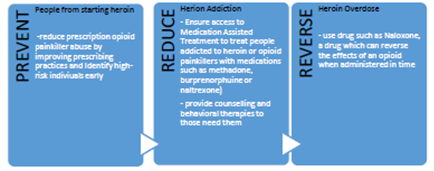
Figure 14 CDC methods of solving the U.S. Heroin epidemic.6
1 Luis Fernando Sanchez Arellano: One of the brothers from the family that run Tijuana Cartel, government had offered a reward for whoever caught him due to his danger to the public be previous actions such as gun battles, exacting revenge on rivals and buying off officials.51
2 OxyContin: when crushed, or chewed and inhaled, injected, or swallowed, the oxycodone is released and absorbed rapidly, producing a heroin-like euphoria. As a result, within 5 years, the popular press and medical authorities in parts of North America began to report the use of oxycodone extended release as a street drug and a growing social problem.60 route.
3 Statistical data does not take into account unreported crimes existing throughout the Country, the homicide number is almost certainly higher.
4 Osiel Cárdenas Guillén: the head of the Gulf Cartel, which controls much of the drug traffic across the border in South Texas, arrested in March 2003, sentenced to 25 years for pleading guilty to five counts in a lengthy indictment, including drug dealing, money laundering and the attempted murder and assault of federal agents. He also forfeited $50 million in assets.50
5 Strychnine - a stimulant used as rat poison which induces violent convulsions and is deadly.
Heroin trafficking is still a common issue for border security at crossings and other sectors along the U.S.-Mexican border. It is apparent that efforts over the years, however drastic, by both the U.S. and Mexican government have been unsuccessful at completely eradicating the problem. There is cause for serious reform to address issues which prevail within society on each side of the border. There is however hope that the problem can be minimized through concerted cooperation between the two countries. Reform required is within government bodies and law enforcement agencies in Mexico to remove the bribery and corruption which is rife in these organizations. A reduction in the amount of corruption would reduce the cartels’ power and influence over these agencies. In order for this to happen a large-scale investigation would be required to identify corrupt government officials and law enforcement officers and remove them from office. This would allow the government to fully investigate the cartels, to establish the extent of their influence and power, and to work towards the elimination of the DTOs. This would be a vast task for Mexico if it worked in isolation. Although Mexico is independent from the U.S., help from their more stable and powerful neighbours in the battle against corruption would be hugely beneficial. For example, training programmes for independent corruption investigation squads could be carried out on U.S. territory to minimize cartels influencing the squads during the critical training process. The Mexican government also needs to consider the influence of the low price that farmers are paid for the cultivation of legitimate crops. If farmers received a higher income for the production of such crops, then they would be less influenced by the financial attraction of producing illicit crops to supply the DTOs. One approach could be to encourage more legitimate trade between the countries and improve the demand for crops such as maize in the U.S.
It will not reduce the demand for illicit substances but may increase profit margins for Mexicans who are cultivating products for legal trade thereby switching production away from illegal crops to legitimate crops potentially reducing levels of production. In addition to increased collaboration between the two countries to reduce the supply of heroin crossing the border, the U.S. needs to reduce the demand for heroin within the country. The high demand has been highlighted as a grave problem within the country and has put severe pressure on health services and law enforcement agencies. Policies have been established in order to help abusers address their addiction but further work in the area is required. It is unlikely that the demand will be removed completely due to the vast population within the U.S. making it almost impossible to control as a whole. However, reducing the overall demand will reduce the amount of Mexican heroin trafficked across the border and the power of the cartels. Steps have been made to address certain issues, such as improvements within the U.S. healthcare system to tackle the problems of drug addiction and reduce the demand for such substances. Education of the young and impressionable will play a vital role in this war on drugs.
None.
None.

©2016 Hagan, et al. This is an open access article distributed under the terms of the, which permits unrestricted use, distribution, and build upon your work non-commercially.